
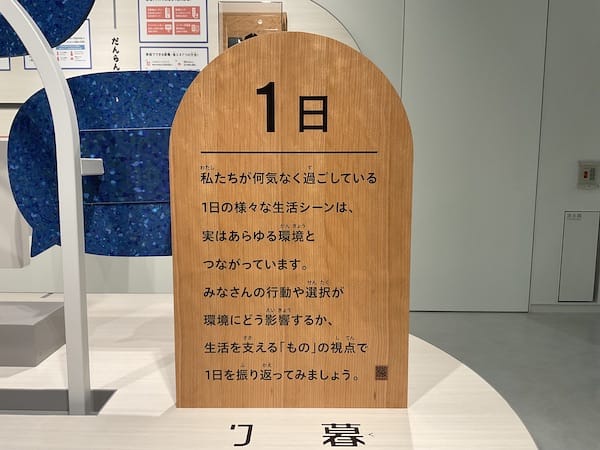
1 day

The various scenes where we spend our day to day life without much
thought are actually deeply tied to every environment.
Let's reflect on a day from the perspective of "things" that support
our lives, to see how our actions and choices affect the
environment.
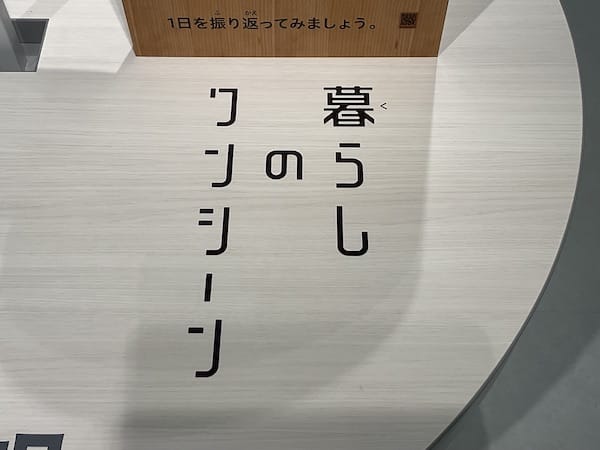
Scenes of daily life
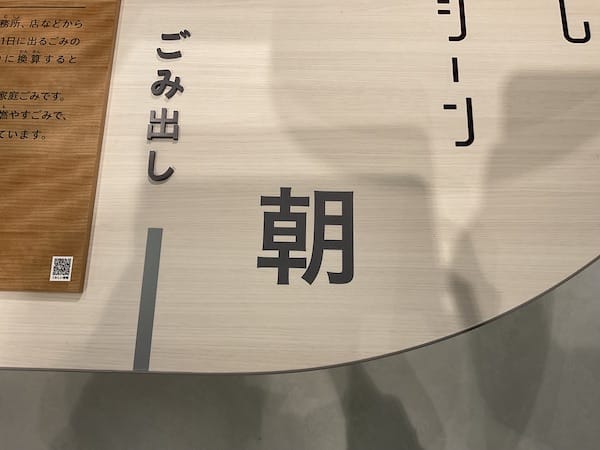
Morning
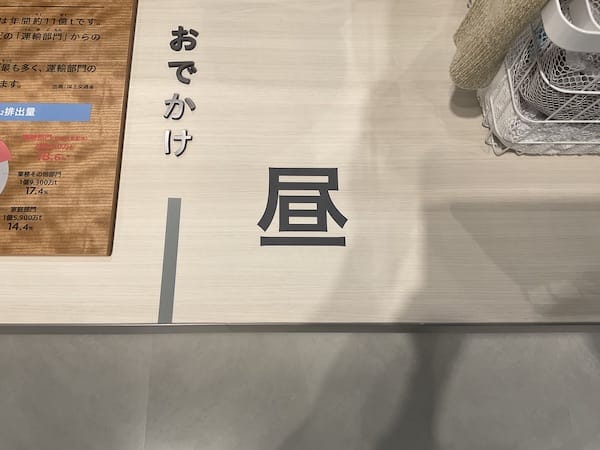
Afternoon
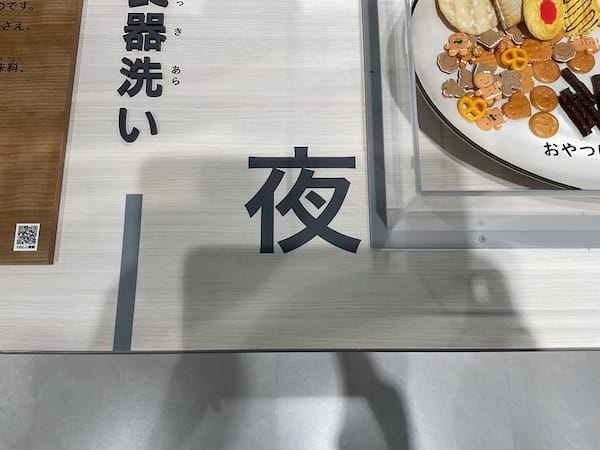
Night
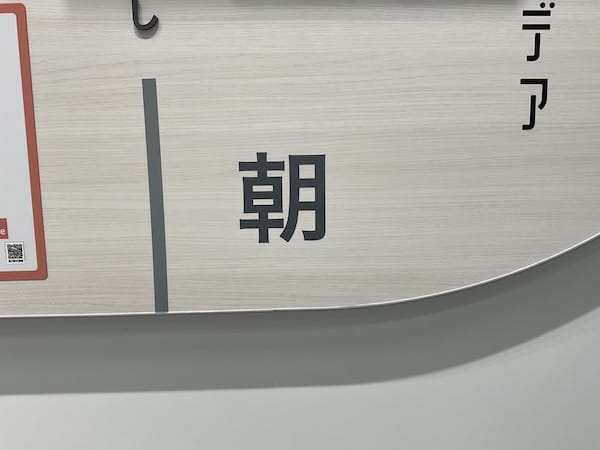
Morning
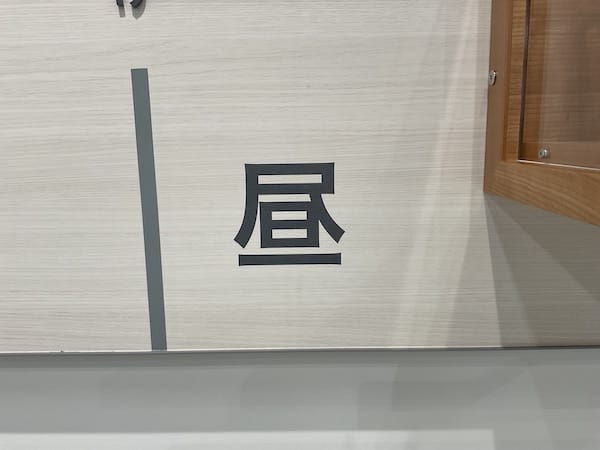
Afternoon
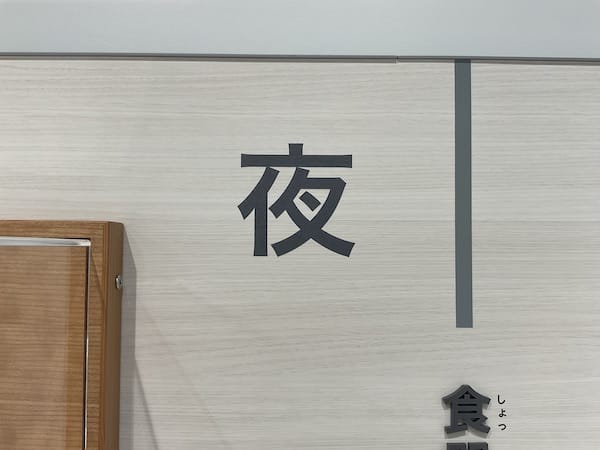
Night
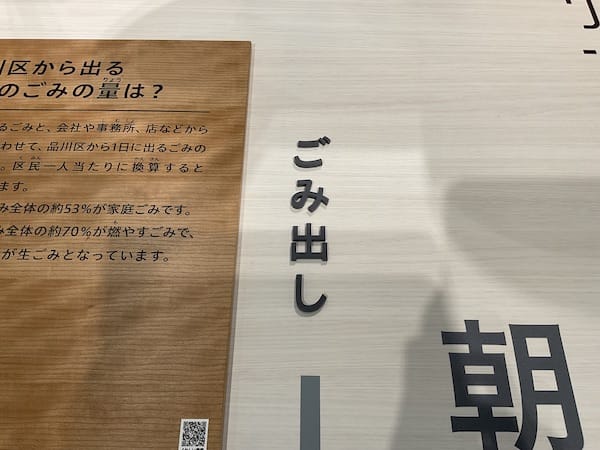
Disposing of garbage
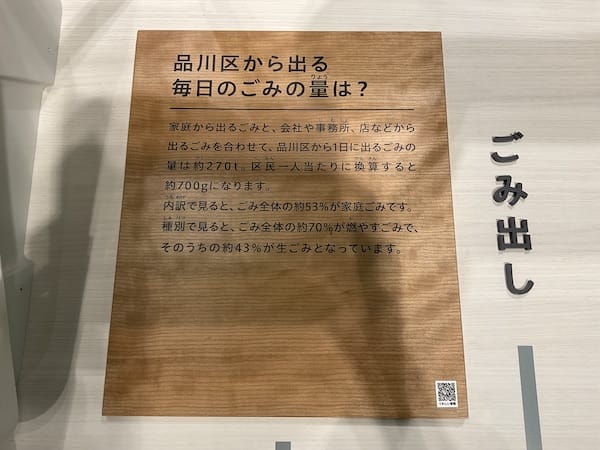
How much garbage does Shinagawa City produce every day?
Shinagawa City produces about 270 tons of garbage every day,
including garbage from homes, companies and offices, and various
stores. That amounts to about 700 grams per resident.
Looking at a breakdown by source, household garbage accounts for
about 53%.
Looking at the types of garbage, about 70% of all garbage from the
city is burnable garbage, and about 43% is food garbage.
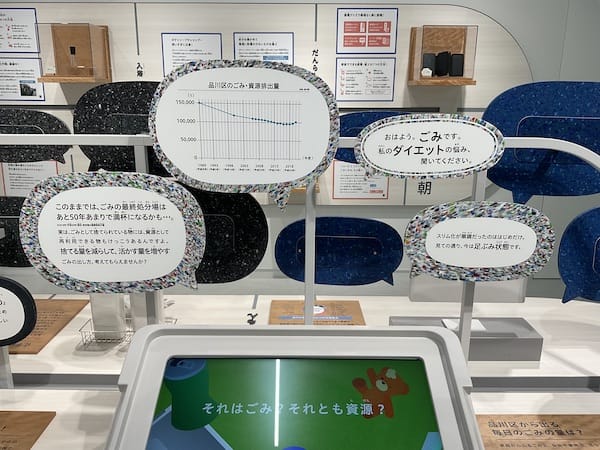
Good morning. I'm garbage. Please listen to my diet problems.
I only slimmed down well at the beginning.
As you can see, I seem to have plateaued.
At this rate, landfills for garbage may be full in about 50
years...
*As of 2018: Landfills of Tokyo Metropolis
Actually, there are many things that get thrown away as garbage
which we can reuse as resources. Can you think of ways to reduce the
amount of garbage you throw away and increase the amount you reuse?
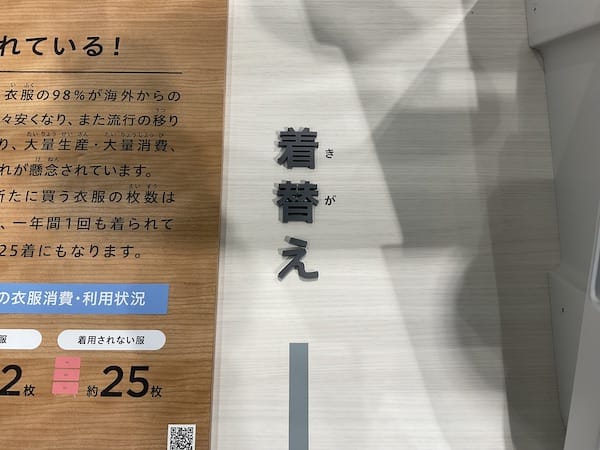
Change of clothes
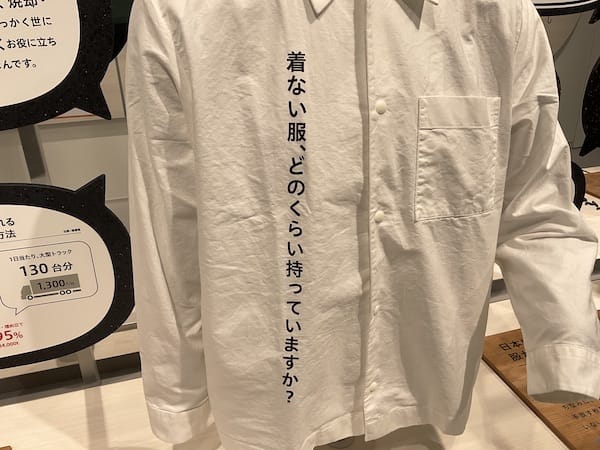
How many clothes do you have that you don't wear anymore?
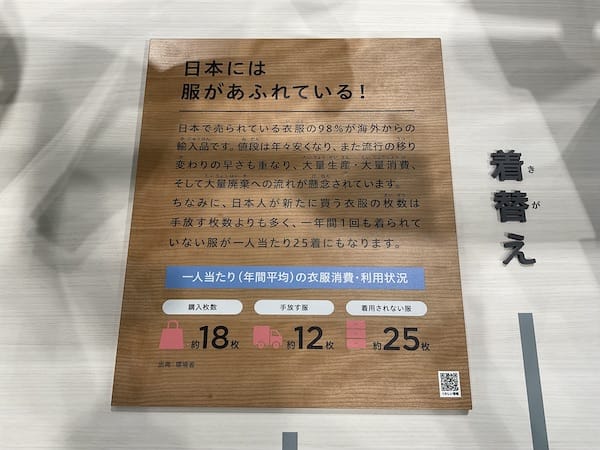
Japan is overflowing with clothes!
98% of clothes sold in Japan are imported from abroad.
Clothing prices are getting cheaper every year, and fashion trends
change very quickly, causing concern about mass production, mass
consumption, and mass disposal.
Japanese people tend to buy more clothes than they get rid of, so on
average each person in Japan has 25 articles of clothing that they
have not worn even once in a year.
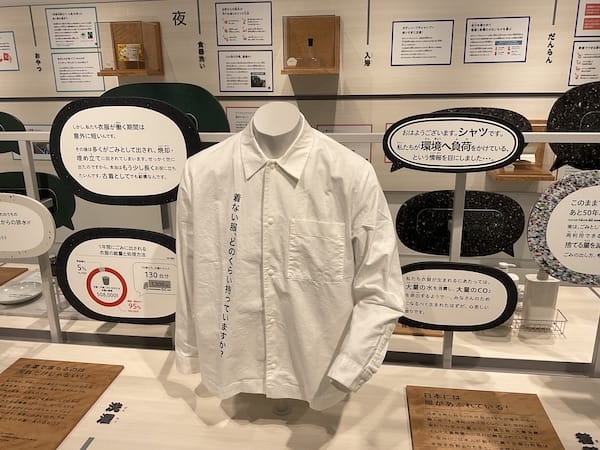
Good morning! I'm a shirt.
I saw information saying that we put a burden on the
environment...
It seems that when we clothes are made, we consume a huge amount of
water and emit a huge amount of CO2... It pains me to think of this,
because we were made to benefit people.
However, we clothes work for a surprisingly short time.
After that, most of us are put in the garbage and sent to
incinerators or landfills.
Now that I'm out in the world, I want to be useful for a little
longer. I'm fine working as second-hand clothes.
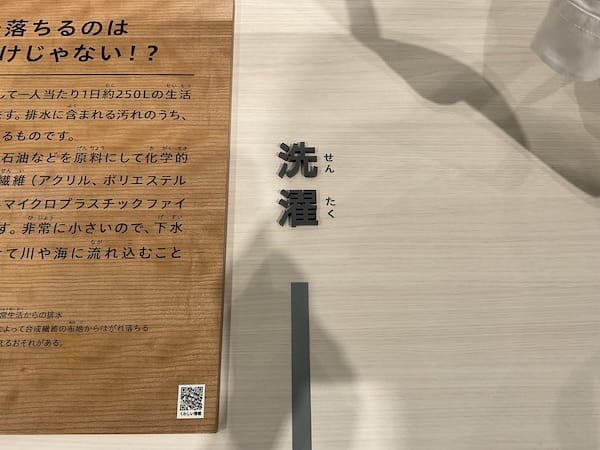
Laundry
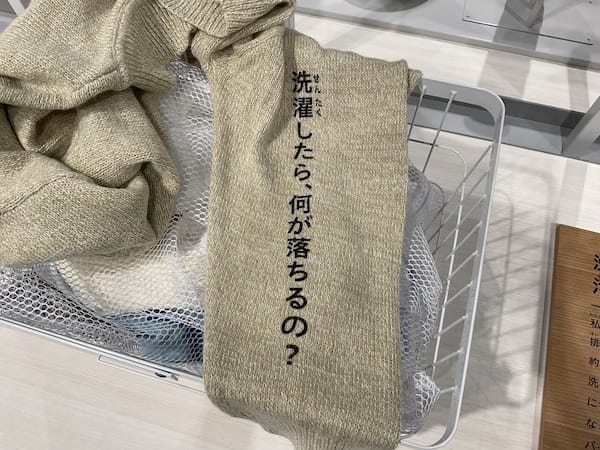
What comes off clothes when you do the laundry?
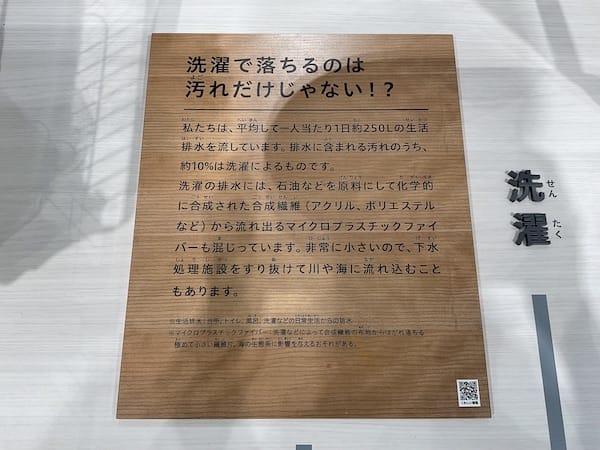
Dirt isn't the only thing that comes off clothes when you do the
laundry!
On average, we drain about 250 liters of household wastewater per
person per day. About 10% of dirt in this wastewater is from
laundry.
Microplastic fibers that washed off synthetic fibers chemically
synthesized from petroleum (acrylic, polyester, etc.) also mix into
wastewater from laundry. These fibers are so small that they can
flow right through sewage treatment plants, and into rivers and the
sea.
*Household wastewater: Wastewater from daily life, including
kitchens, toilets, baths, and laundry.
*Microplastic fibers: Extremely small pieces of fiber that strip off
synthetic fiber fabric in the wash. They can have an effect on the
ecosystem of the sea.
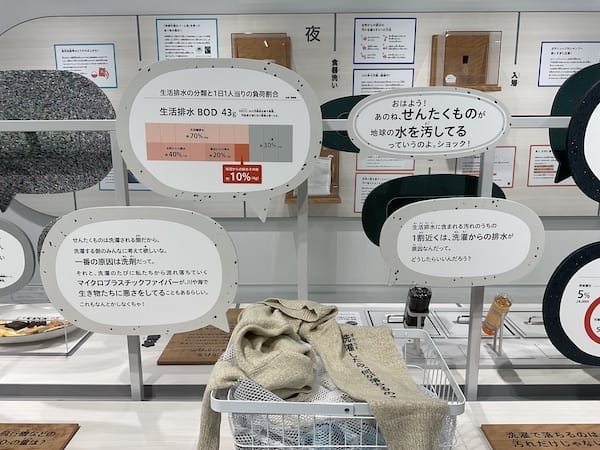
Good morning! They say laundry is polluting the water of the Earth.
What a shock!
Nearly 10% of dirt in household wastewater is caused by wastewater
from laundry. What should we do about this?
*BOD: An index of the degree of water pollution. The higher the
pollution level is, the higher the BOD value will be.
I want you guys on the washing side to think, not the position of
the laundry to be washed.The fact that laundry detergent is the
biggest cause.
Also, it seems the microplastic fibers that flow off of us every
time we get washed hurts creatures living in rivers and the sea. We
have to do something about this too!
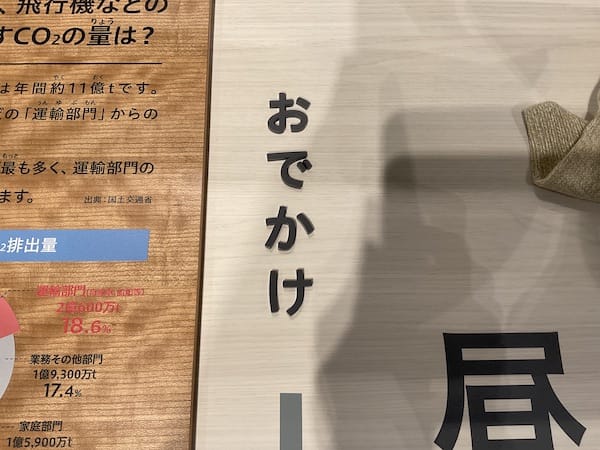
Outings
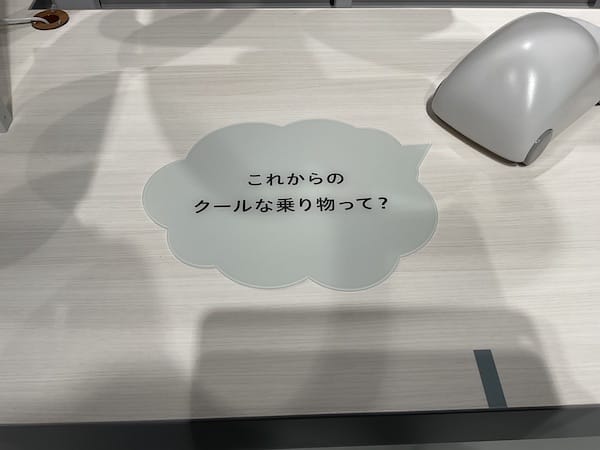
What cool vehicles will there be in the future?
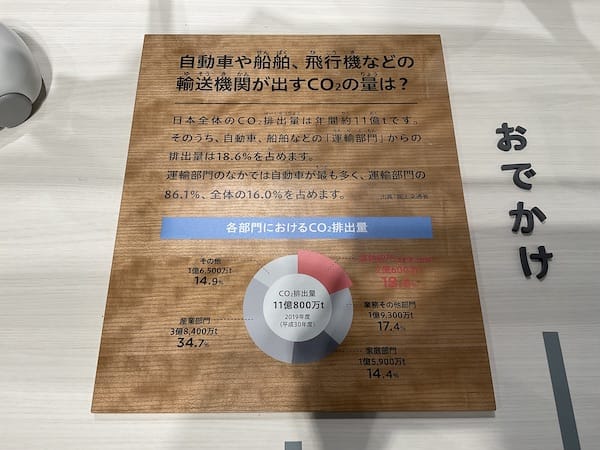
How much CO2 is emitted by transportation such as cars, ships, and
airplanes?
Total CO2 emissions in all of Japan are about 1.1 billion tons per
year. Of this, 18.6% are emissions from the transportation sector,
including cars and ships.
Within the transportation sector, cars emit the most, accounting for
86.1% of the transportation sector and 16.0% of total CO2 emissions.
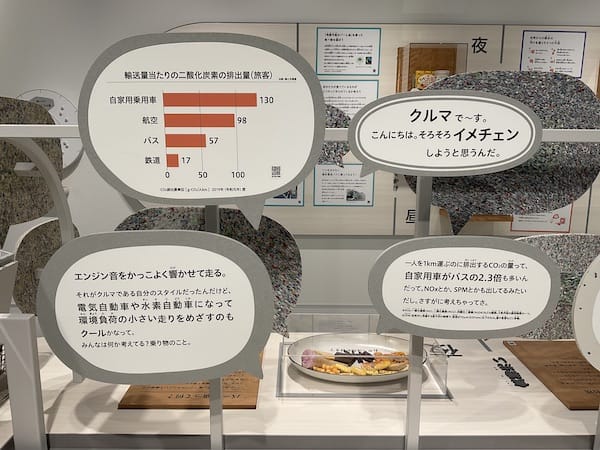
Good afternoon. I'm a car.
I'm thinking of getting a makeover.
The amount of CO2 emitted to carry one person one kilometer is 2.3
times as much for cars as for buses. Cars also emit INOx and SPM.
That really gets me thinking.
*NOx: The general term for nitric oxide (NO), nitrogen dioxide
(NO2), dinitrogen tetroxide (N2O4), etc. NOx is one of the
substances that cause air pollution.
*SPM (Suspended particulate matter): Particles with diameter of 10
μm (0.01 mm) or smaller that float in the air. SPM is harmful to the
lungs and trachea.
It's cool to drive fast with the engine revving.
That's my style as a car, but it would also be cool to become an
electric car or hydrogen car and aim to reduce my environmental
burden.
Have you thought of anything to do with vehicles?
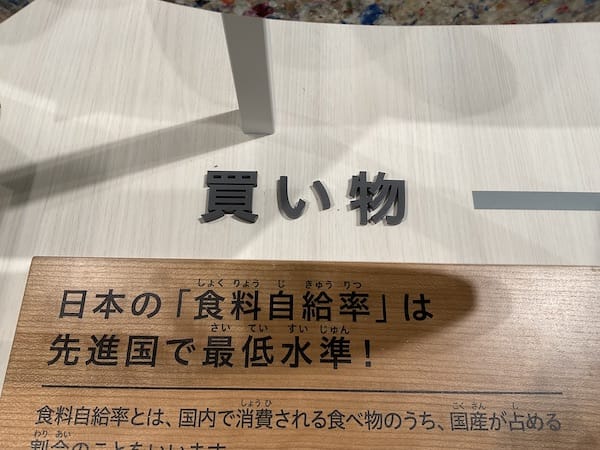
Shopping
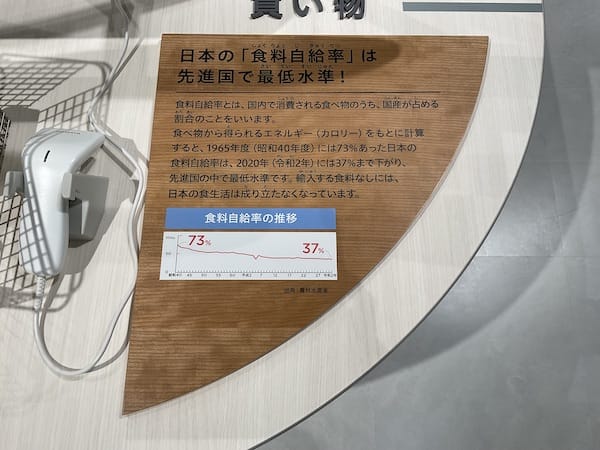
Japan has the lowest food self-sufficiency rate among developed
countries!
The food self-sufficiency rate is the ratio of food produced in a
country to food consumed in that country.
Calculated on the basis of energy (calories) obtained from food,
Japan's food self-sufficiency rate peaked in 1965 at 73%, but
bottomed out in 2020 at 37%, the lowest level of any developed
country.
Without imported food, Japanese dietary life would not be possible.
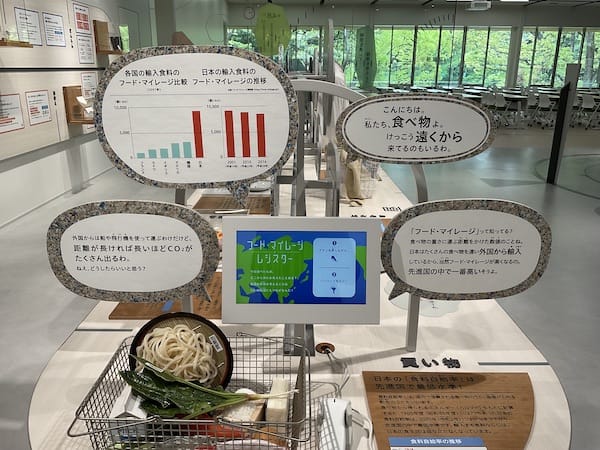
Good afternoon. We are food.
Some of us come from very far away.
Do you know the term "food mileage?" It is the product of the weight
of food multiplied by the distance it is carried. Japan imports a
lot of food from distant foreign countries, so of course Japan's
food mileage is high. In fact, it is the highest of any developed
country.
Food is carried to Japan from abroad by ship or by plane, and the
longer the distance food travels, the more CO2 is emitted.
What do you think we should do?

Snacks
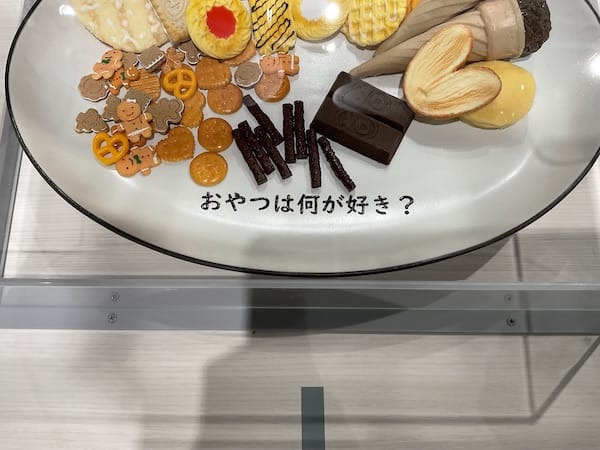
What snacks do you like?
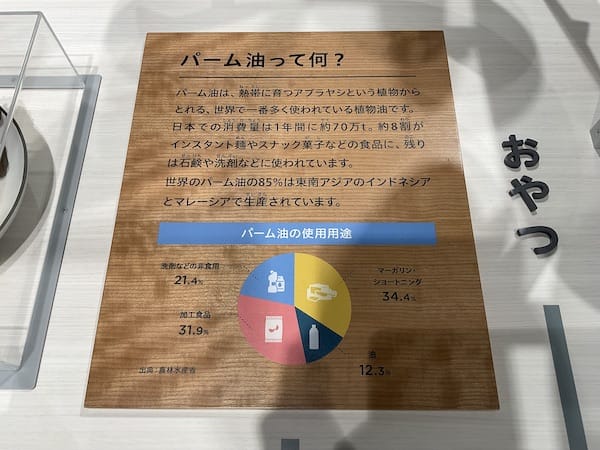
What is palm oil?
Palm oil is the most commonly used vegetable oil in the world, made
from oil palms grown in tropical regions.
About 700,000 tons of palm oil are consumed in Japan every year.
About 80% of this oil is used for food products such as instant
noodles and snack foods, while the rest is mostly used for soaps and
detergents.
85% of the world's palm oil is produced in the countries of
Indonesia and Malaysia in Southeast Asia.
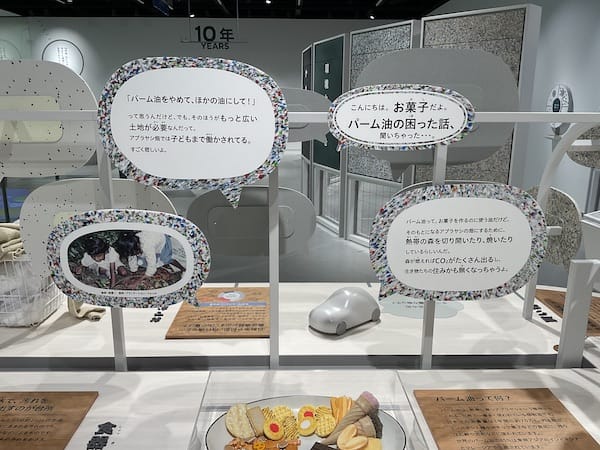
Good afternoon. I'm candy.
I heard that troubling talk about palm oil...
Palm oil is used to make candy. It seems that we are cutting down
and burning tropical rainforests to make oil palm plantations where
we can source that oil.
When a forest burns, tons of CO2 is emitted, and the creatures that
live there disappear.
You might be thinking "Stop using palm oil and use another oil!" but
doing that would require even more land.
Even children are made to work on oil palm plantations. It's so sad.
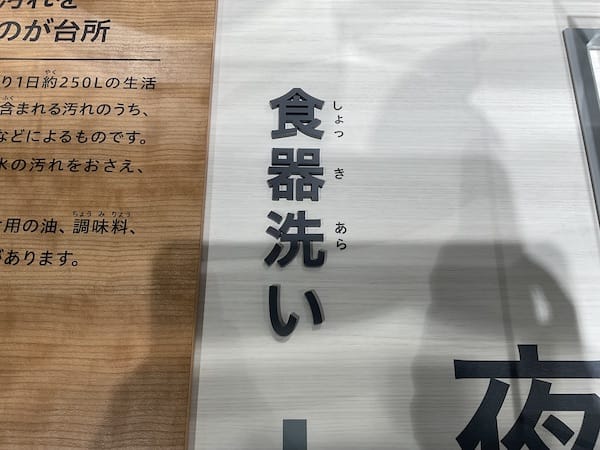
Dishwashing
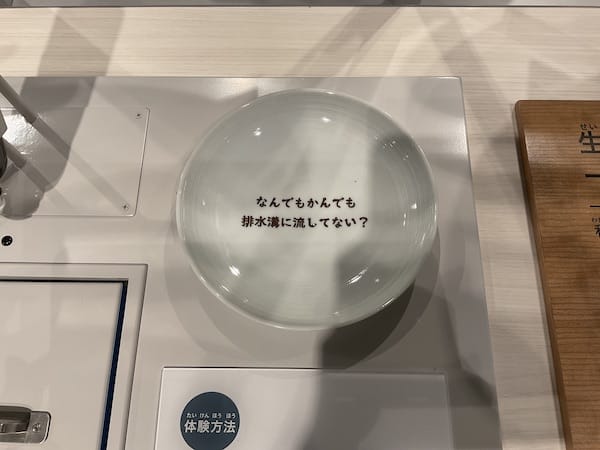
Are you flushing everything down the drain?
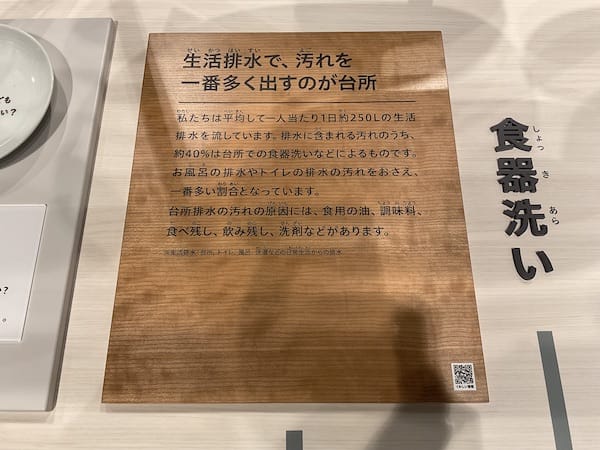
The kitchen is the source of household wastewater that produces the
most dirt
On average, we flush about 250 liters of household wastewater per
person per day. About 40% of the dirt in that wastewater is caused
by dishwashing in the kitchen. This is the largest ratio of dirt,
exceeding the dirt in bath wastewater or toilet wastewater.
Sources of dirt in kitchen drainwater include cooking oil,
seasonings, leftover food and drink, as well as detergents.
*Household wastewater: Wastewater from daily life, flushed from
kitchens, toilets, baths, laundry, etc.
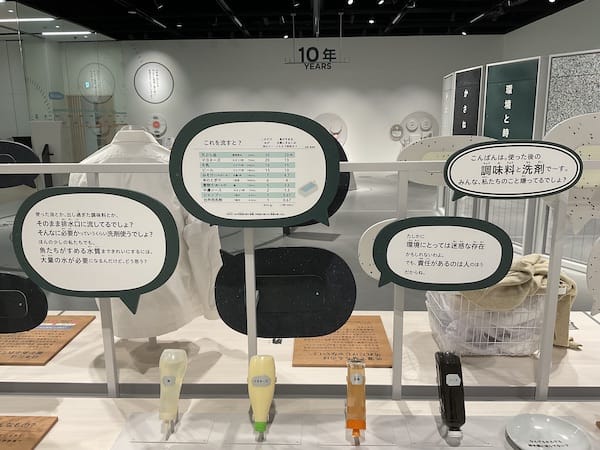
Good evening. We're the used seasonings and detergents. I guess you
hate us.
Sure, we're not very good for the environment. But it's the people
who are responsible for this.
Isn't the oil used by people and the seasonings that have been put
out too much drained directly into the drain?
Many people use more detergent than they really need to, don't
they?
It takes a whole lot of water to dilute us until water quality is
good enough for fish to live in. What do you think of that?
*BOD: An index of the degree of water pollution. The higher the
pollution level is, the higher the BOD value will be.
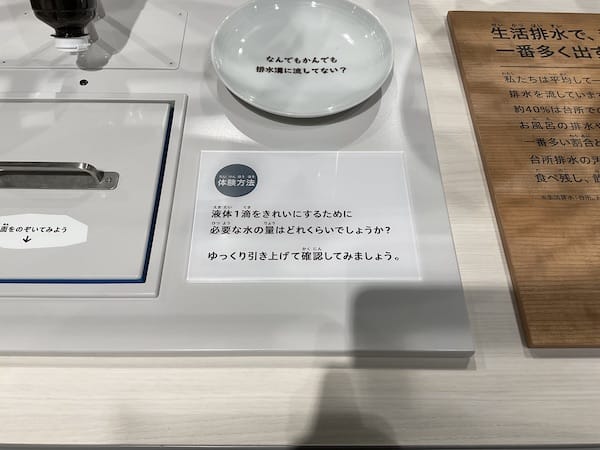
How much water is necessary to clean a single drop of water?
Lift up slowly to check.
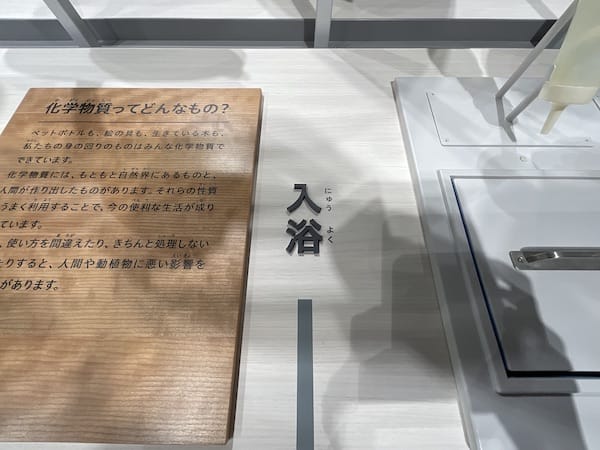
Bathing
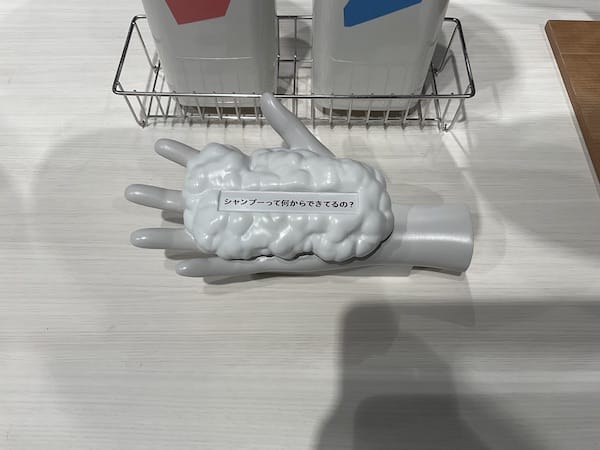
What is shampoo made of?
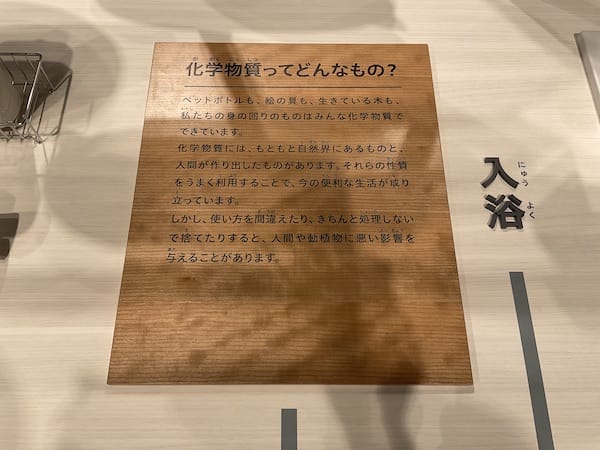
Just what are chemicals?
PET bottles, paints, living trees, and everything else around us is
made of chemicals.
Chemical substances include those already found in nature, and those
produced by humans. By skillfully exploiting the properties of these
chemicals, we are able to make the convenient lifestyle that we
enjoy today.
However, misusing or disposing of chemicals without proper treatment
can cause a negative impact on humans, other animals, and plants.
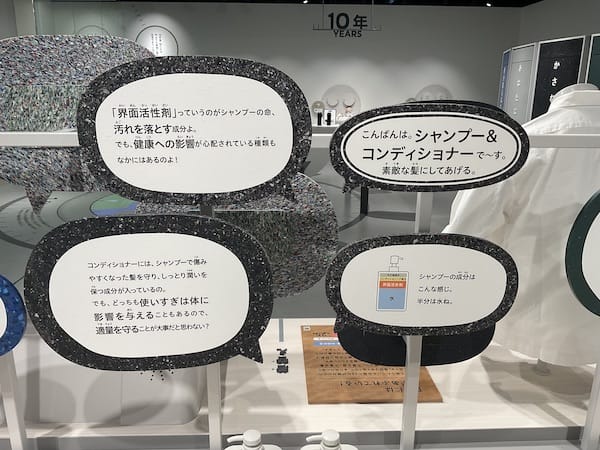
Good evening. We're shampoo and conditioner.
We give you wonderful hair.
These are the ingredients of shampoo. Half is water.
A surfactant removes dirt, so it is the key ingredient of
shampoo.
However, some surfactants bring health concerns.
Conditioner contains ingredients that protect hair made easily
damaged by shampoo, and keeps hair moisturized.
However, using either shampoo or conditioner too much can impact
your body, so don't you think it is important to use the right
amount?
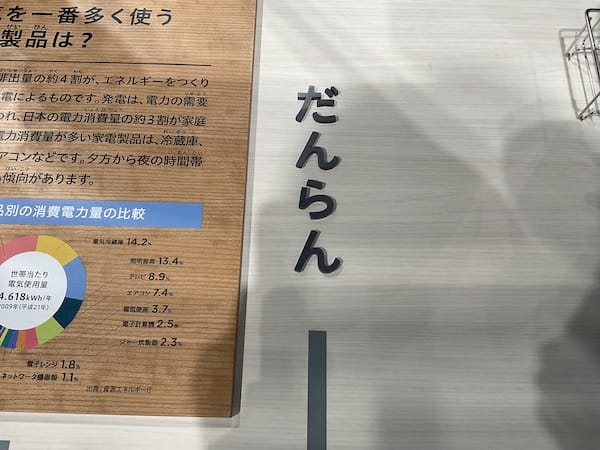
Centerpiece of the home
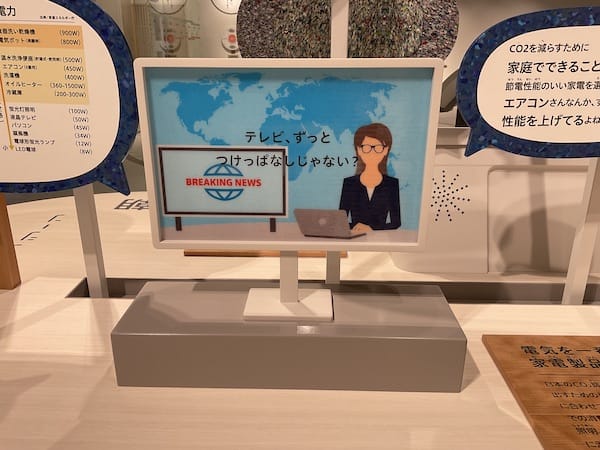
Do you leave your TV on all the time?
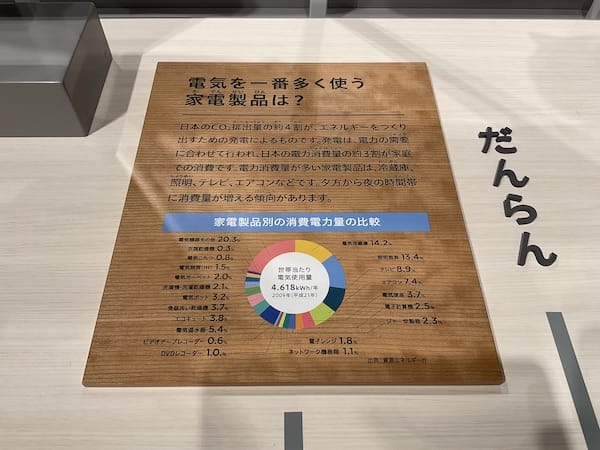
Which home appliances use the most electricity?
About 40% of Japan's CO2 emissions come from power generation to
produce energy.
Power is generated according to demand for electricity, and about
30% of electricity produced Japan is consumed in homes.
Home appliances that consume a lot of electricity include
refrigerators, lights, televisions, and air conditioners.
In particular electricity consumption tends to increase in the hours
from evening to night.
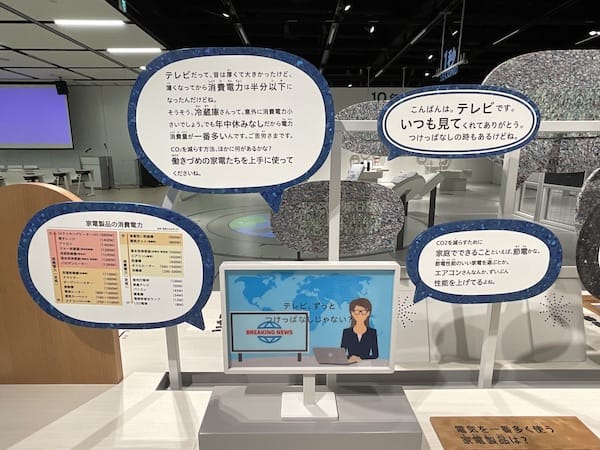
Good evening. I'm a television.
Thank you for watching so often. But sometimes you leave TV on.
The best thing you can do at home to reduce your CO2 emissions is to
save power. That includes choosing home appliances with good power
saving performance. Performance of air conditioners has improved
greatly.
Televisions used to be big and bulky, but since they became thinner,
their power consumption has dropped by more than half.
Even refrigerators consume less power than you would expect. But
because they run all year without stopping, they consume the most
electricity among home appliances. Thanks for your hard work,
fridges!
What else can we do to reduce CO2 emissions?
Please make good use of us home appliances, who are working hard all
the time.
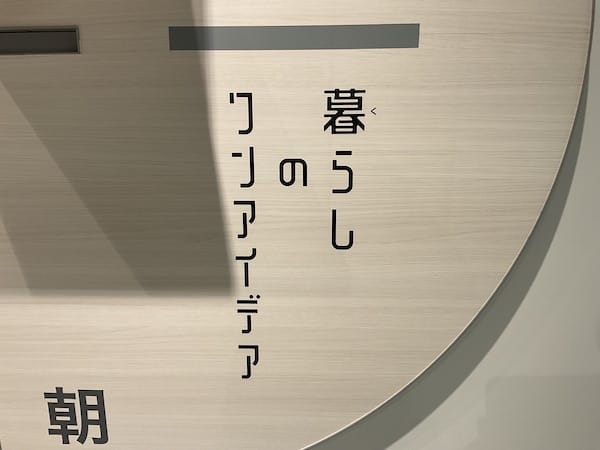
Ideas for better living
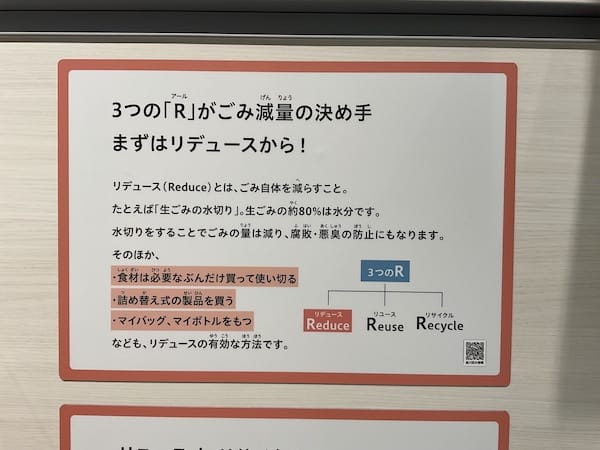
The three Rs are decisive factors for less waste
Start with Reduce!
Reduce means making less garbage in the first place.
For example, that includes draining water from food waste.
About 80% of food waste is water. Draining water reduces the volume
of garbage, and helps prevent rotting and foul odors.
In addition, you can...
・Only buy as much food as you need, and use it all.
・Buy products that can be refilled.
・Bring your own bags and bottles.
These are also effective means of reducing waste.
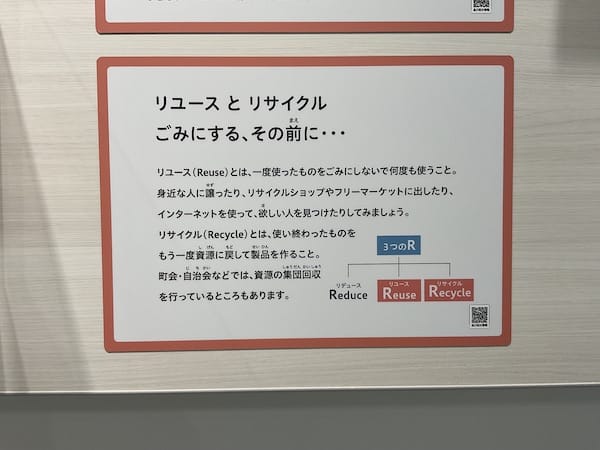
Reuse and recycle
Before you make garbage...
Reuse means using the same product over and over again.
You could give it to someone familiar, put it up for sale in a
thrift store or flea market, or use the Internet to find someone who
wants it.
Recycling means turning used products into resources for making new
products.
Some neighborhood or resident associations collect resources as
groups.
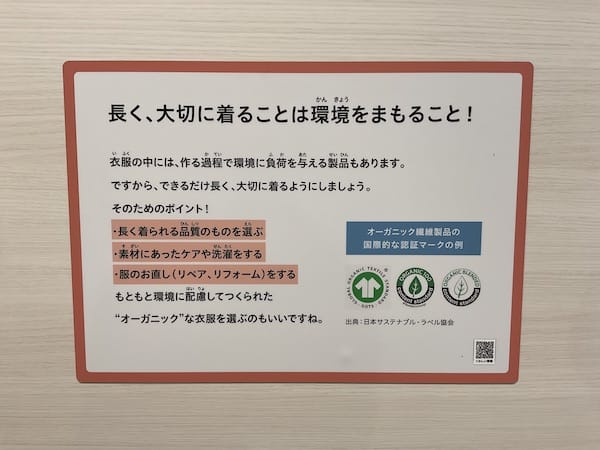
Wearing clothes carefully for a long time
helps to protect the environment!
Some clothing products make an impact on the environment in their manufacturing process.
For that reason, you should wear your clothes carefully for as long as possible.
Here are important points to do that!
・Choose quality clothes you can wear for a long time.
・Care for and clean clothes appropriately for each fabric
・Mend your clothes (repairs, etc.)
You can also choose organic clothing that is made with consideration for the environment.
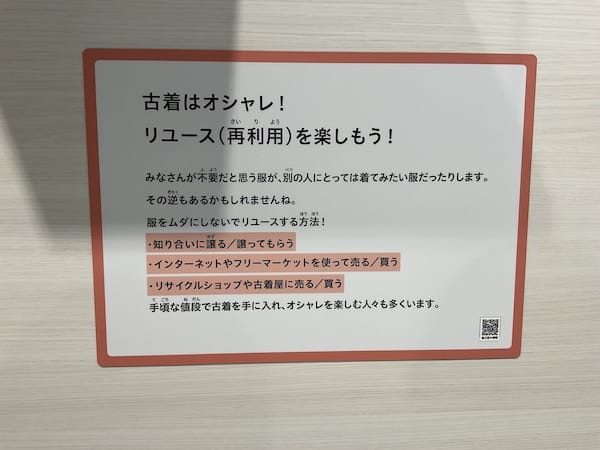
Used clothes are fashionable!
Enjoy reusing clothes!
Clothes that you don't need anymore may be clothes that other people
want to wear.
The opposite might also be true.
Here is how you can reuse clothes without wasting them!
・Give them to or get them from acquaintances.
・Sell or buy them on the Internet or at flea markets.
・Sell or buy at thrift stores or used clothing stores
A growing number of people buying used clothes at reasonable
prices and enjoying fashion.
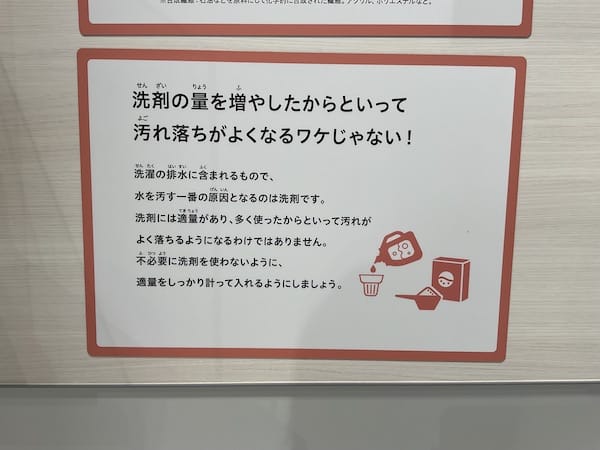
Just adding more detergent does not
guarantee that dirt will come off better!
Detergent is the greatest cause of water pollution among
contaminants contained in laundry wastewater.
There is a proper amount of detergent to use. Just because you use a
lot of detergent do not mean that dirt will come off better. Make
sure to measure the proper amount of detergent so that you do not
use too much.
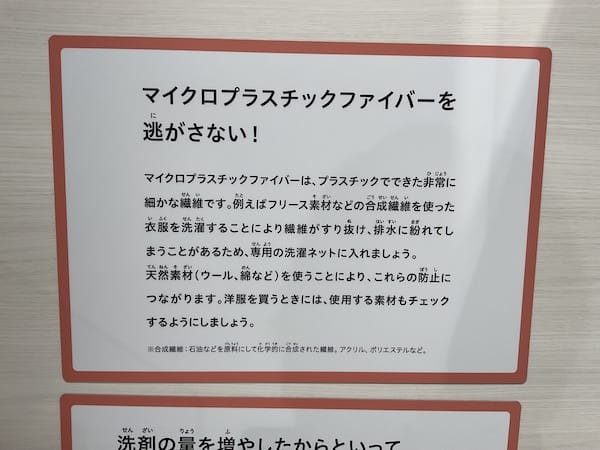
Don't let microplastic fibers escape!
Microplastic fibers are very fine fibers made of plastic. For
example, if you wash clothes made of synthetic fibers such as polar
fleece, fibers will slip through the machine and into the
wastewater, so you should those clothes in special laundry nets.
Using natural materials such as wool and cotton will help prevent
this from happening. When you buy clothes, make sure to check what
materials were used to make them.
*Synthetic fiber: A fiber chemically synthesized from raw materials
such as petroleum.
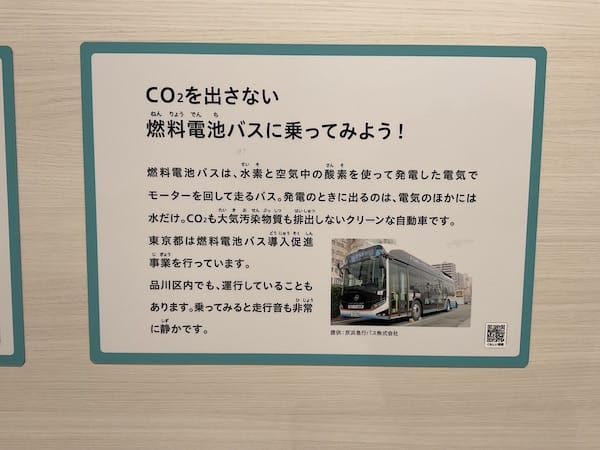
Take a ride on a
fuel cell bus that doesn't emit CO2!
Fuel cell buses are driven by motors that run on electricity
generated using hydrogen and the oxygen in the air. When generating
electricity, the only other thing they produce is water. They are
clean vehicles that do not emit CO2 or other air pollutants.
The Tokyo Metropolitan Government is running a project to promote
introduction of fuel cell buses. Some of these buses even run in
Shinagawa City. Try riding one of these buses, and you'll find they
are very quiet when running.
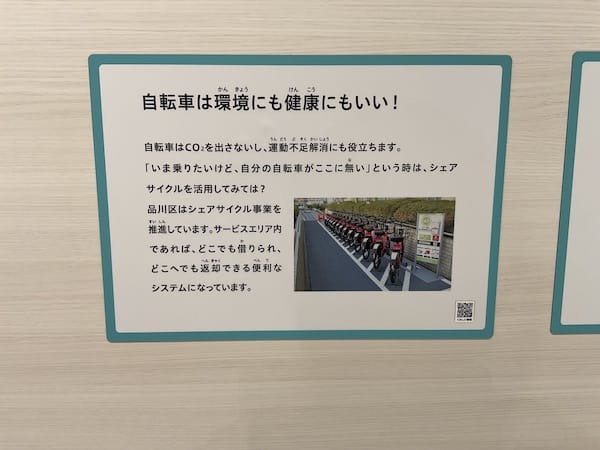
Bicycles are good for the environment and your health!
Bicycles do not emit CO2, and are a great way to exercise.
Have you ever wanted to ride a bicycle, but don't have yours with
you? In that case, you should try bicycle sharing.
Shinagawa City is promoting a bicycle sharing business. It is a
convenient system that allows you to rent and return bicycles
anywhere in the service area.
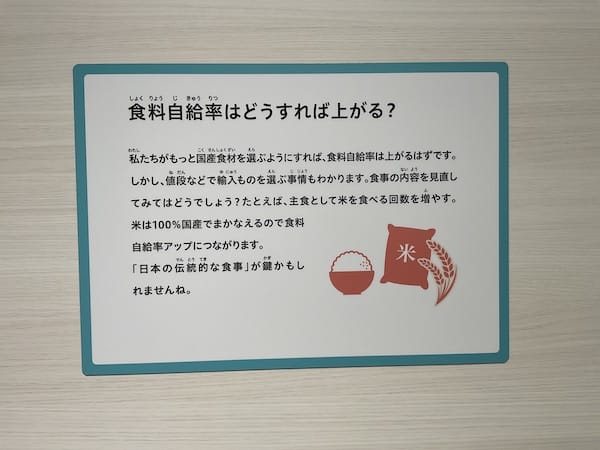
How can we increase our food self-sufficiency rate?
If we choose domestically produced ingredients, we can raise our
food self-sufficiency rate. However, circumstances such as prices
make it understandable that we often choose imported products.
Why not reconsider what you eat?
For example, you could eat rice more often. Rice can be covered 100%
with crops grown in Japan, helping to increase our food
self-sufficiency rate.
Traditional Japanese meals may be the key to solving this problem.
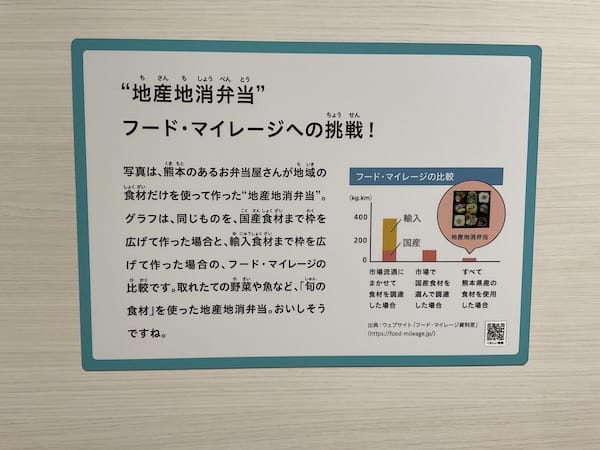
"Bentos locally produced for local consumption"
Working to reduce food mileage!
The photograph is of a "bento locally produced for local
consumption" made using only local ingredients by a bento shop in
Kumamoto.
The graph is a comparison of food mileage when using only
domestically grown ingredients and when using imported
ingredients.
Bento locally produced for local consumption using seasonal
ingredients, such as fresh vegetables and fish. It looks delicious.
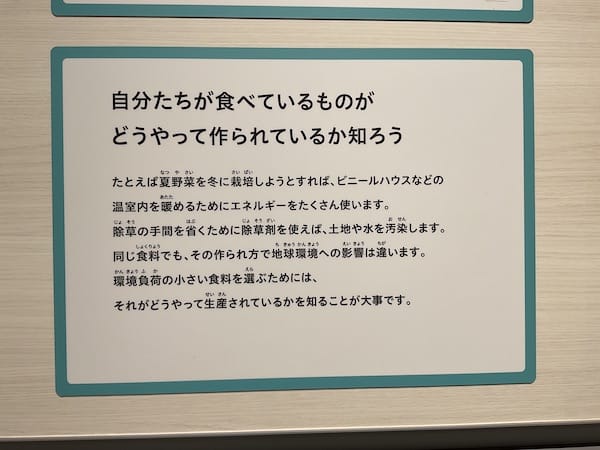
Let's learn how the food we eat is made
For example, if you try to grow summer vegetables in winter, it will
take a lot of energy to heat them inside a greenhouse or other
structure. If you use herbicides to save effort weeding, it will
contaminate the land and water.
The same food can have different effects on the global environment
depending on how it is made.
In order to choose foods that have a low environmental impact, it is
important to know how they are produced.
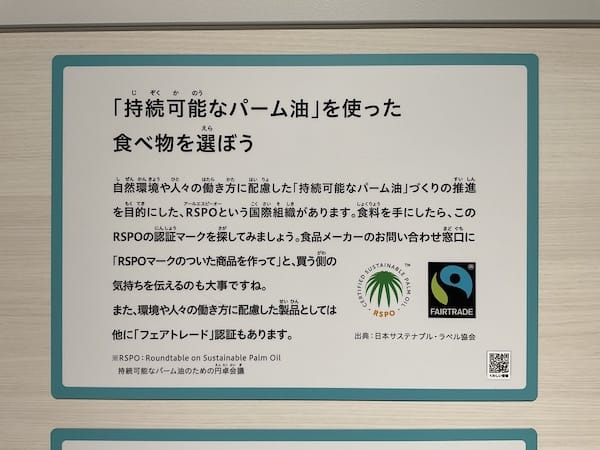
Choose foods that use sustainable palm oil
There is an international organization called RSPO, which aims to
promote production of sustainable palm oil, taking into
consideration the natural environment and work styles.
When you get food, look for the RSPO certification mark.
It is also important that you communicate your feelings as a buyer
by contacting food manufacturers and telling them to "Make products
with the RSPO mark." There is also "Fair Trade" certification,
indicating products made with consideration for the environment and
work styles.
*RSPO: Roundtable on Sustainable Palm Oil
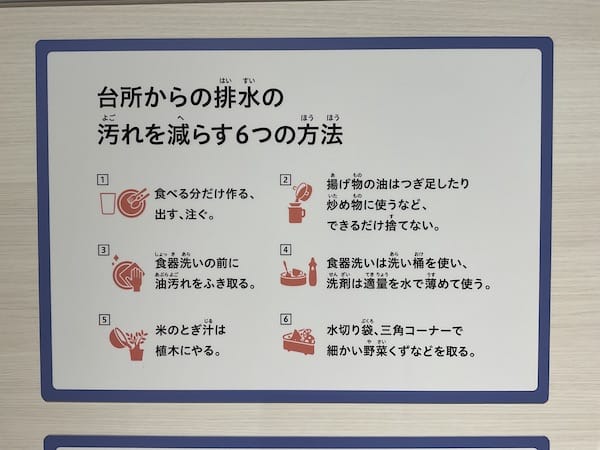
6 ways to reduce dirt in wastewater from your kitchen
1) Only make and serve as much as you intend to eat.
2) Throw away deep frying oil as little as possible, and use it for
stir-fry or other food instead.
3) Wipe off oil before washing dishes.
4) Use a washing tub to wash dishes, and dilute a proper amount of
detergent in water before using it.
5) Use water in which you washed rice to water plants.
6) Catch fine vegetable scraps in a drain bag or a triangular sink
tidy.
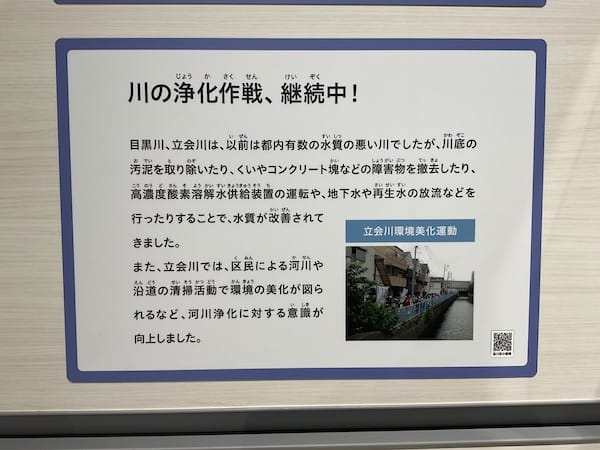
River purification efforts are underway!
The Meguro River and Tachiai River used to have the worst water
quality among rivers in Tokyo. However, their water quality has been
improved by myriad efforts. Sludge was scraped off and obstacles
such as piles and chunks of concrete were removed from riverbeds.
High-concentration oxygen-dissolved water supply devices were put
into operation. Groundwater and reclaimed water were discharged into
rivers.
In the case of the Tachiai River, awareness of river purification
was improved through initiatives such as sending residents of
Shinagawa City to beautify the environment by cleaning rivers and
roadsides.
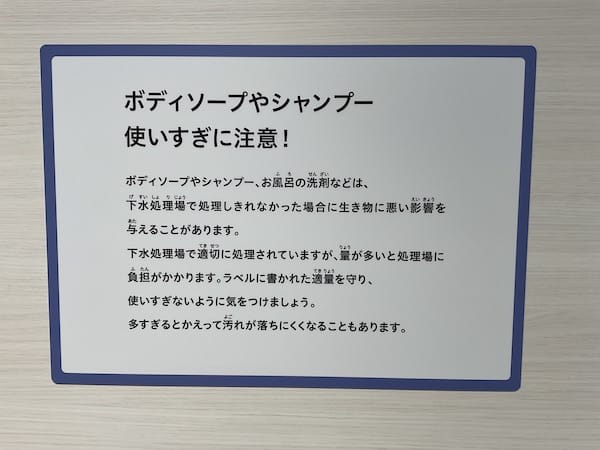
Be careful not to overuse
body soap and shampoo!
Body soaps, shampoos, and bath cleaners can have a negative impact
on living things if they are not fully treated at a sewage treatment
plant.
While they are properly treated at sewage treatment plants, if the
volume is high, this places a burden on the treatment plant.
Use the proper amount shown on the label, and be careful not to use
too much.
If you use too much, it may actually be more difficult to remove
dirt.
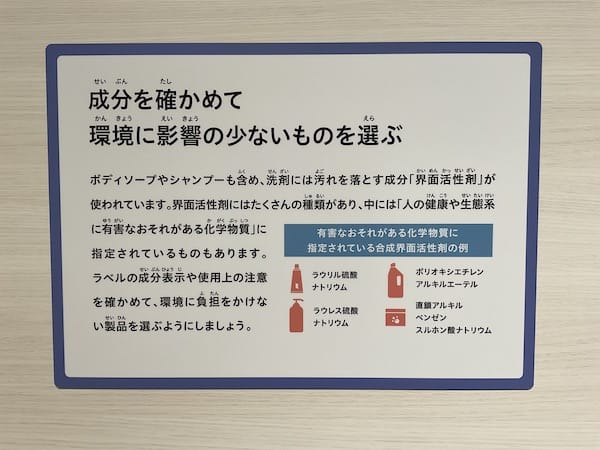
Check ingredients and choose ones
with less impact on the environment
Detergents, which also includes body soaps and shampoos, use
"surfactants," the ingredients that remove stains.
There are many types of surfactants, some of which are designated as
"chemicals potentially harmful to human health and the
ecosystem."
Check ingredients and precautions shown on the label, and choose a
product that does not burden the environment.
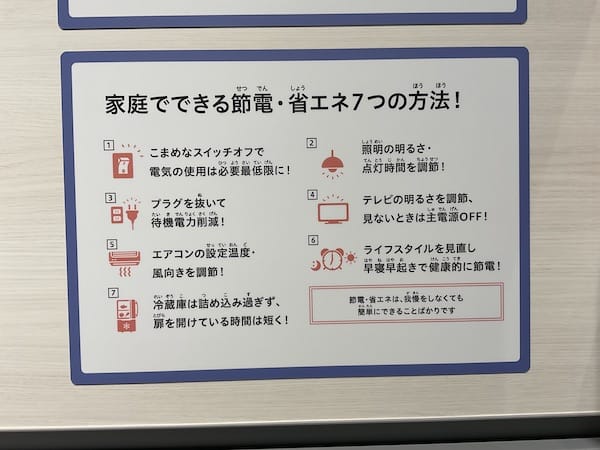
7 ways to save electricity and save energy at home!
1) Turn switches off when you are finished to keep electricity use
to a minimum!
2) Adjust the brightness and timing of lighting!
3) Unplug devices to reduce standby power consumption!
4) Adjust the brightness of your television and turn off the main
power when you are not watching it!
5) Adjust the temperature setting and wind direction of your air
conditioner!
6) Reconsider your lifestyle and save electricity for your health by
going to bed early and waking up early!
7) Keep your refrigerator from overloading by only opening the door
for a short time!
You can save electricity and energy easily, without suffering
difficulties.
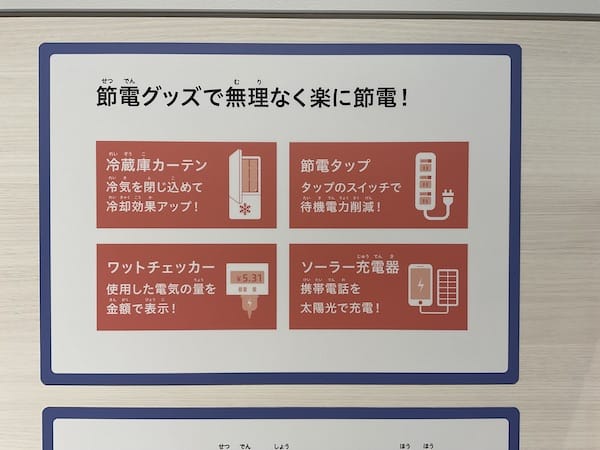
Power saving products make it easy!
● Refrigerator curtain
Keep your refrigerator cooler by trapping cold air inside!
● Power saving taps
Reduce standby power consumption with tap switches
● Watt checker
Displays electricity used in terms of money!
● Solar power charger
Charge your mobile phone with sunlight!

Have you thought about what you can do for the environment in your daily life?